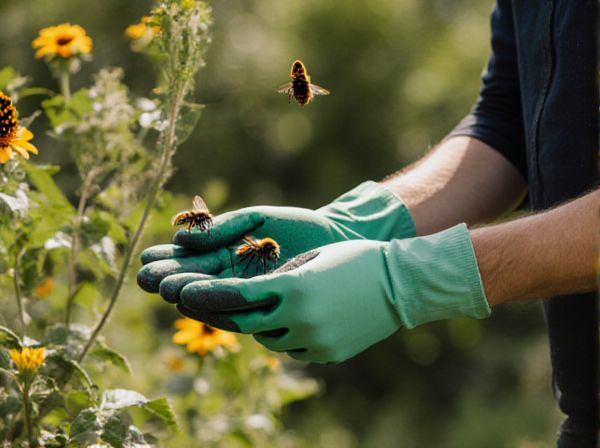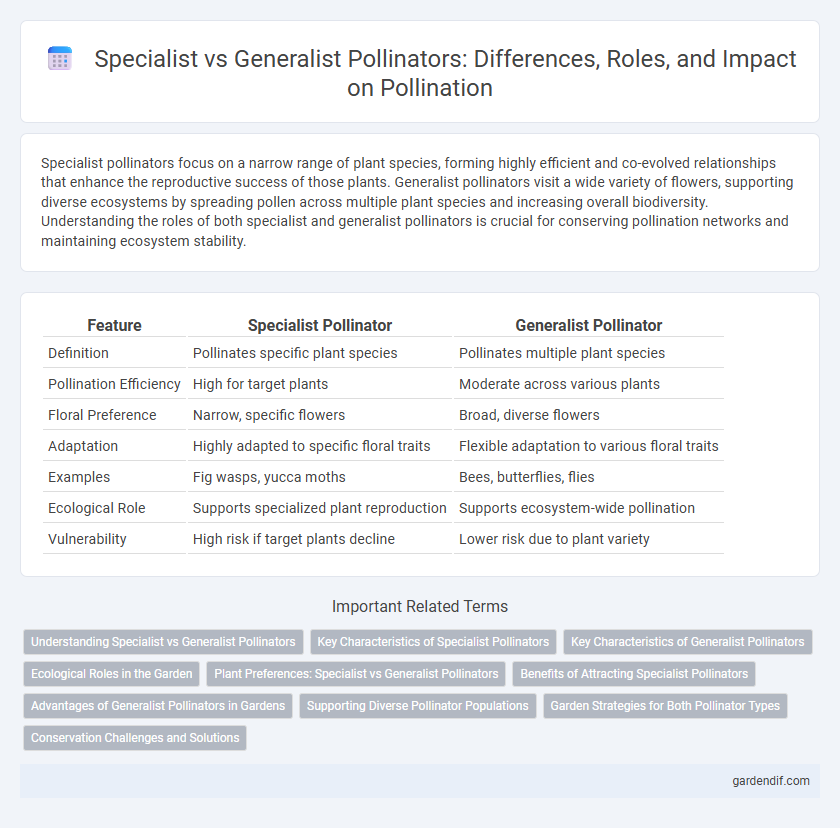
Specialist pollinator vs Generalist pollinator Illustration
Specialist pollinators focus on a narrow range of plant species, forming highly efficient and co-evolved relationships that enhance the reproductive success of those plants. Generalist pollinators visit a wide variety of flowers, supporting diverse ecosystems by spreading pollen across multiple plant species and increasing overall biodiversity. Understanding the roles of both specialist and generalist pollinators is crucial for conserving pollination networks and maintaining ecosystem stability.
Table of Comparison
| Feature | Specialist Pollinator | Generalist Pollinator |
|---|---|---|
| Definition | Pollinates specific plant species | Pollinates multiple plant species |
| Pollination Efficiency | High for target plants | Moderate across various plants |
| Floral Preference | Narrow, specific flowers | Broad, diverse flowers |
| Adaptation | Highly adapted to specific floral traits | Flexible adaptation to various floral traits |
| Examples | Fig wasps, yucca moths | Bees, butterflies, flies |
| Ecological Role | Supports specialized plant reproduction | Supports ecosystem-wide pollination |
| Vulnerability | High risk if target plants decline | Lower risk due to plant variety |
Understanding Specialist vs Generalist Pollinators
Specialist pollinators target specific plant species, providing efficient and reliable pollination services for flora with unique floral traits. Generalist pollinators visit a wide range of flowers, supporting diverse ecosystems but often with less precision in pollen transfer. Understanding the roles and behaviors of specialist versus generalist pollinators is crucial for conservation strategies and maintaining plant-pollinator network stability.
Key Characteristics of Specialist Pollinators
Specialist pollinators exhibit a high degree of flower constancy, often relying on a specific plant species or genus for nectar and pollen, which enhances pollination efficiency. They possess morphological adaptations, such as specialized body parts or tongue lengths, that allow precise pollen transfer tailored to the flowers they visit. This specialization fosters mutualistic relationships, promoting coevolution and increased reproductive success for both the pollinator and the host plant species.
Key Characteristics of Generalist Pollinators
Generalist pollinators exhibit a broad foraging behavior, visiting a wide variety of flowering plants, which enhances ecosystem resilience and plant reproductive success. They possess adaptable feeding structures that enable effective pollen transfer across diverse floral morphologies, increasing pollination efficiency in heterogeneous environments. These pollinators, including bees like Apis mellifera and butterflies such as Vanessa cardui, contribute significantly to agricultural productivity by supporting multiple crop species.
Ecological Roles in the Garden
Specialist pollinators, such as certain species of bees that exclusively visit specific plants, enhance pollination efficiency and promote genetic diversity within specialized plant communities. Generalist pollinators, including honeybees and butterflies, support broader ecological stability by visiting a wide variety of flowers, facilitating cross-pollination across diverse plant species in the garden. Together, these pollinator types maintain ecosystem resilience, ensuring sustainable fruit and seed production essential for garden health.
Plant Preferences: Specialist vs Generalist Pollinators
Specialist pollinators exhibit strong fidelity to specific plant species or closely related groups, enhancing efficient pollen transfer and increasing plant reproductive success. Generalist pollinators visit a wide variety of flowering plants, providing broader pollination services but often with less precision. Plant preferences impact co-evolutionary relationships, where specialists promote specialized floral traits, while generalists support more generalized flower structures.
Benefits of Attracting Specialist Pollinators
Specialist pollinators provide enhanced pollination efficiency by focusing exclusively on specific plant species, ensuring higher pollen transfer rates and improved plant reproduction. Plants attracting these pollinators benefit from reduced pollen wastage and increased genetic diversity within species through targeted pollen exchange. This close mutualism fosters co-evolution, promoting plant adaptation and long-term ecosystem stability.
Advantages of Generalist Pollinators in Gardens
Generalist pollinators, such as honeybees and bumblebees, enhance garden biodiversity by visiting a wide variety of flowering plants, ensuring consistent pollination across different species. Their flexibility in foraging on multiple floral types provides resilience against environmental changes and fluctuations in floral availability. This broad diet not only supports diverse plant reproduction but also stabilizes garden ecosystems by promoting pollinator diversity and abundance.
Supporting Diverse Pollinator Populations
Specialist pollinators, such as certain bee species that exclusively visit specific plants like the yucca or squash, play a critical role in the reproduction of specialized flora, ensuring genetic diversity and ecosystem stability. Generalist pollinators, including honeybees and bumblebees, support ecosystem resilience by visiting a wide variety of flowering plants, facilitating cross-pollination across multiple species. Conserving both specialist and generalist pollinator populations enhances overall biodiversity, promotes healthy plant communities, and sustains agricultural productivity through diverse pollination services.
Garden Strategies for Both Pollinator Types
Specialist pollinators, such as certain bees and butterflies, thrive on targeted plant species, so garden strategies should include native or single plant varieties that provide consistent and reliable nectar and pollen sources. Generalist pollinators, like honeybees and hoverflies, benefit from diverse floral resources, making it essential to incorporate a wide range of flowering plants that bloom throughout the growing season. Combining native specialists with a variety of generalist-friendly plants enhances biodiversity and supports sustainable pollination services in garden ecosystems.
Conservation Challenges and Solutions
Specialist pollinators, such as certain bee species dependent on specific plants, face higher risks from habitat loss and floral resource depletion, requiring targeted conservation strategies like habitat restoration and plant-specific preservation. Generalist pollinators benefit from a diverse range of floral resources but still suffer from pesticide exposure and climate change impacts, demanding broad-scale habitat conservation and pesticide regulation. Effective pollinator conservation combines protecting specialist niches with maintaining diverse ecosystems to support generalist species, ensuring resilient pollination networks.
Specialist pollinator vs Generalist pollinator Infographic

 gardendif.com
gardendif.com